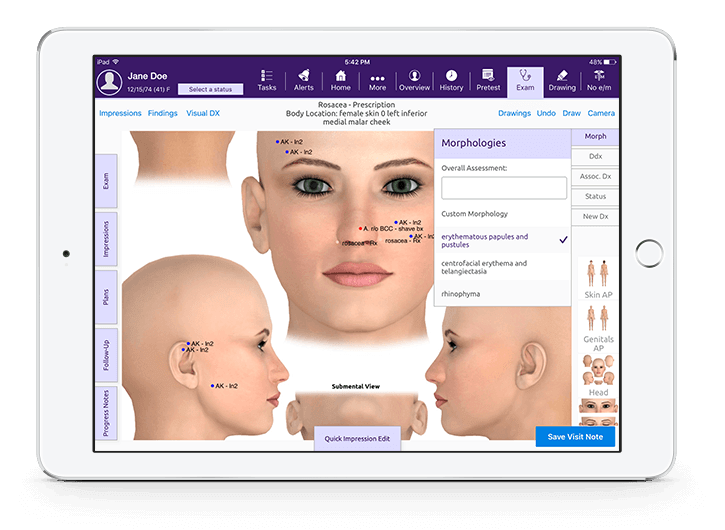Tips to Avoid ‘Rookie Mistakes’ When Starting a Private Dermatology Practice

Industry insights when setting up a medical practice
Doctors learn the business of medicine mostly through personal experience. I can honestly say that I learned very little about how to start or run my own practice in medical school or during my dermatology residency and fellowship. For a growing number of new and early graduates, the idea of accountability to both patients and a medical corporation is becoming less palatable. While starting your own practice can be accomplished in many different ways, much of it depends on personal style. It takes thorough planning, multitasking and a lot of perseverance. That being said, there are some universal ‘rookie mistakes’ you’ll want to avoid regardless of where, how or why you’ve decided to open your own dermatology private practice.
Here are some pitfalls that you may want to avoid:
Don’t choose the wrong location.
 Unsure whether a new dermatology clinic makes sense in your area? Evaluate the number of practices that already exist in the surrounding location. What services do they provide? Do they offer mainly cosmetic dermatology services? Do they specialize in dermatology surgery? This information may help determine the need depending on your area of focus. Do a little investigating and call practices to see how long it would take for an appointment. Long wait times could signal that there’s a void, and a new dermatology practice could flourish. Also understand the area’s residents and their needs, too. Do most people reside in the area full-time? Is it more of a vacation destination? What are the demographics? Due diligence before deciding on a location can be crucial.
Unsure whether a new dermatology clinic makes sense in your area? Evaluate the number of practices that already exist in the surrounding location. What services do they provide? Do they offer mainly cosmetic dermatology services? Do they specialize in dermatology surgery? This information may help determine the need depending on your area of focus. Do a little investigating and call practices to see how long it would take for an appointment. Long wait times could signal that there’s a void, and a new dermatology practice could flourish. Also understand the area’s residents and their needs, too. Do most people reside in the area full-time? Is it more of a vacation destination? What are the demographics? Due diligence before deciding on a location can be crucial.
Don’t wait until one or two months prior to opening to apply for insurance credentialing.
![]()
It can take six to 12 months or even longer to have your name added to public and private insurer networks. You’ll need some basics in place first including a physical address, a medical license, proof of malpractice insurance and a National Provider Identifier (NPI) number, if you plan to take Medicare or Medicaid. You may want to plan your timeline accordingly based on the date you anticipate opening and backtrack from there.
Don’t try to do it all yourself.
 It’s unlikely you’ll have expertise in accounting, legal considerations, practice management best practices and dermatology billing on top of your clinical skills and acumen. For this reason, you may want to think about possibly hiring an accountant, attorney and/or a dermatology practice management consultant to help jump-start your practice. Dermatology billing not your strong point? Proper accounting practices can make or break your fledgling practice. Consider a dermatology practice management system to help track and manage your revenue cycle management.
It’s unlikely you’ll have expertise in accounting, legal considerations, practice management best practices and dermatology billing on top of your clinical skills and acumen. For this reason, you may want to think about possibly hiring an accountant, attorney and/or a dermatology practice management consultant to help jump-start your practice. Dermatology billing not your strong point? Proper accounting practices can make or break your fledgling practice. Consider a dermatology practice management system to help track and manage your revenue cycle management.
Don’t underestimate the financial commitment.
 The cost to start a dermatology practice varies depending on several variables, but most medical practices can take about $100,000 to open and another $100,000 to operate. Even if you’ve saved enough money to start a dermatology practice, you might need a loan to cover ongoing salary and other operating costs. I have found that banking representatives often have excellent contacts within the community.
The cost to start a dermatology practice varies depending on several variables, but most medical practices can take about $100,000 to open and another $100,000 to operate. Even if you’ve saved enough money to start a dermatology practice, you might need a loan to cover ongoing salary and other operating costs. I have found that banking representatives often have excellent contacts within the community.
Not sure how to obtain financing for your new dermatology clinic? The American Academy of Dermatology (AAD) offers a ‘Starting and Marketing a Dermatology Practice for Solo Practices’ manual, as well as a related publication for multispecialty and group dermatology practices.
Don’t start without a solid plan.
 A practice management consultant can help you devise a strategic dermatology practice business plan. This can include the essential steps you’ll need to take to help work towards maximizing your success and avoiding expensive mistakes. If you’re opening a new dermatology private practice with associates, a good way to help ensure you have the same goals and priorities for the practice includes conferring on the business plan. Medical Economics outlines 10 general considerations, seven revenue-related items and a list of 35 expense-related concerns, including the anticipated monthly salary draw for physicians, in “How to build a strategic business plan for your practice.”
A practice management consultant can help you devise a strategic dermatology practice business plan. This can include the essential steps you’ll need to take to help work towards maximizing your success and avoiding expensive mistakes. If you’re opening a new dermatology private practice with associates, a good way to help ensure you have the same goals and priorities for the practice includes conferring on the business plan. Medical Economics outlines 10 general considerations, seven revenue-related items and a list of 35 expense-related concerns, including the anticipated monthly salary draw for physicians, in “How to build a strategic business plan for your practice.”
Don’t forget about the dermatology software you’ll need.
 Evaluate all the options available to help select the best dermatology software for your practice such as an EHR system, practice management system, analytics, revenue cycle management and patient engagement tools. Take time to schedule demos with dermatology EHR vendors, talk with your peers, ask for client references and investigate options during industry conferences and events.
Evaluate all the options available to help select the best dermatology software for your practice such as an EHR system, practice management system, analytics, revenue cycle management and patient engagement tools. Take time to schedule demos with dermatology EHR vendors, talk with your peers, ask for client references and investigate options during industry conferences and events.
One of our dermatology clients, Dr. Obed, shared his personal story opening his own private dermatology practice along with some helpful tips and success he’s experienced using the dermatology EHR EMA™.
The technology you select to help run your new dermatology practice can have a huge impact on whether or not your practice runs smoothly and efficiently. Choosing the right dermatology software can make difficult tasks like value-based payments and MIPS/MACRA much more manageable. Consider an integrated dermatology practice management and EHR system from Modernizing Medicine on your short list.
